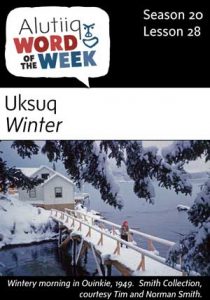 Tamuuliciqukut uksurpailan.–We will make dry fish before the winter.
Tamuuliciqukut uksurpailan.–We will make dry fish before the winter.
Winter in the Kodiak Archipelago quickly follows summer. As the days darken and stormy weather sets in, the landscape turns rapidly from green to brown, the temperature drops, and wet, windy days replace the warmer, foggy days of fall. In Prince William Sound, Alutiiq children once marked the first days of winter by making string figures. String games were intended to entangle the sun, slowing its seasonal disappearance.
Subsistence harvesting continues in winter. However, economic activities are usually those that can be conducted on or near land: deer hunting, bird hunting, and plant collecting. Lowbush cranberries, Labrador tea, and licorice ferns are some of the plant resources that continue to be harvested in the winter. Cranberries, collected in windswept areas where the snow has been blown away, are often eaten as they are picked. On calm days, people will venture out in their boats to hunt and fish, but sea mammals, halibut, and cod range farther from shore in the cold season and can be harder to catch.
Winter is also a time for social activities. People gather to visit, celebrate, and share the fish and game harvested over the past year. In classical Alutiiq society, many of these activities took place in the qasgiq, or community house. These large, single-roomed structures were built much like traditional houses. They were framed from driftwood, covered in sod, and had benches lining the walls. Russian observers noted that most communities had one such structure where men gathered to socialize, plan war parties, discuss political issues, and lead community festivals.
Source: Alutiiq Museum
